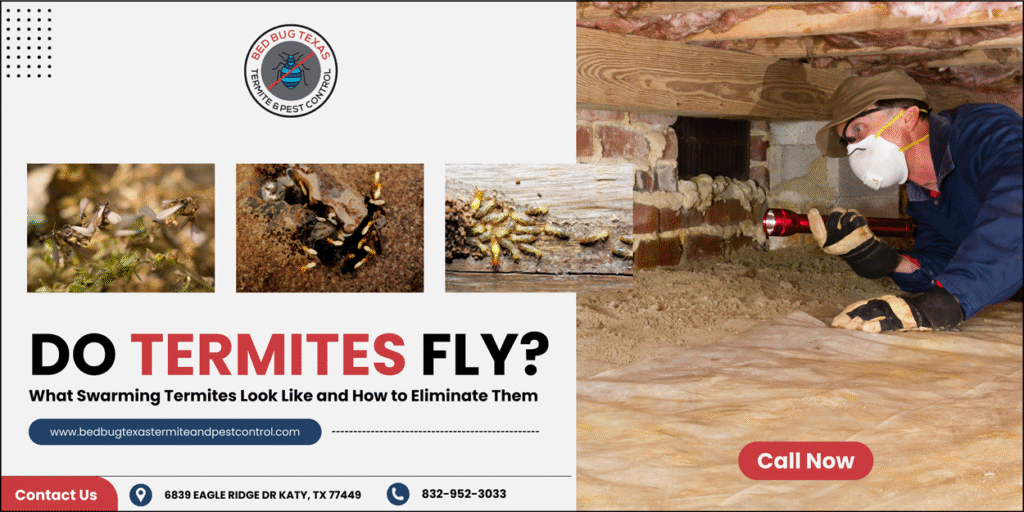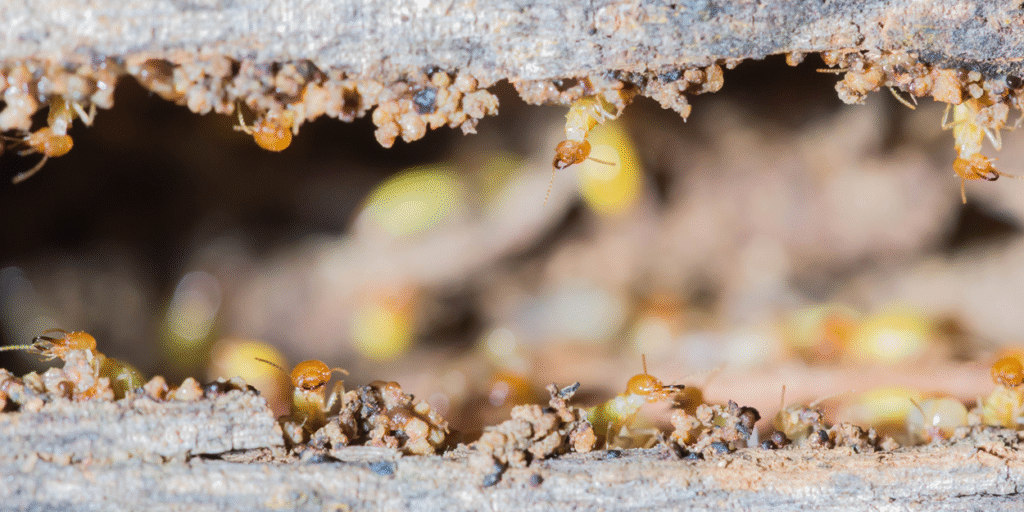
Termites are a serious threat to homes across the entire United States, responsible for billions of dollars in structural damage every year. Most homeowners know that termites eat wood and can destroy a house from the inside out.
But what’s less commonly known is the fact that some termites can even fly, and seeing one could be your first warning before a full-blown infestation begins. The sudden arrival of these winged termites is not random; it’s often the most visible sign of an active termite problem nearby.
In this article, we’ll answer the most crucial question: Which species of termites fly, What do Termites Look Like, and We’ll also provide steps on how to get rid of termites and prevent costly termite damage repair.
Do All Termites Fly?
Well, no, only a small portion of termites grow wings. Here is a quick breakdown of a termite colony:
- Workers: These are soft, wingless, and pale-colored insects. And as the name suggests, they do all the work and cause most damage.
- Soldiers: Soldiers are slightly larger than workers and are also wingless.
- Swarmers: These are also known as Alates and are dark-bodied with two pairs of equal-length wings. These are the ones that you see flying.
So, yes, termites do fly, but only when they are ready to expand their empire, which so happens to be during the swarming season. This season typically happens:
- In spring and summer (especially after a rain)
- When the weather is warm and humid.
- Around doors, windows, basements, or even attics.
If you are in Texas, this could happen as early as March and as late as September, depending on the species and the condition of your home.
How to Differentiate Termites from Flying Ants?
Most people mistake swarming termites for flying ants. Getting it wrong could cost you thousands in repairs. Now, you probably cannot spot the difference with your naked eye unless you are holding both insects side by side with a magnifying glass. It is pretty tough to catch the subtle differences.
So, here’s a general guide to what termites look like and what makes them different from flying ants:
| Basis | Swarming Termites | Flying Ants |
| Body Shape | Straight and Uniform | Pinched at the waist |
| Wings | Two pairs of the same length. | Front wings are larger than back wings. |
| Antennae | Straight | Elbowed |
| Color | Black or dark brown | Varies from black to reddish |
But, again, don’t rely solely on eyesight. The distinctions are subtle, and in most cases, by the time you notice a few flyers, there is already a termite infestation in your home.
Are Flying Termites a Sign of an Infestation?
Yes, definitely. Seeing swarming termites in or around your home is one of the most obvious signs of a mature termite infestation. Other signs include:
- Mud tubes on your walls or foundation
- Bubbling or uneven paint
- Hollow-sounding wood
- Fine wood dust scattered on the floor near wooden structures
- Discarded wings indoors
- Tight-fitting doors or windows (caused by termite warping)
If you see discarded wings on your windowsills or near lights, make a note of that. Termites often shed their wings near the area they’ve chosen to start chewing through wood, so inspect those spots carefully.
That’s why early identification and professional inspection matter more than trying to play insect detective on your own.
Can You Get Rid of Swarming Termites on Your Own?
If you’ve just seen a few flying termites near your window or porch light, you might wonder if DIY solutions are enough. You can take a few proactive steps, but they come with limitations. Here are some practical DIY termite control tips you can start with:
Vacuum Swarmers Immediately
If you spot some swarmers indoors, vacuum them up right away. This does not eliminate the colony, but it does stop them from spreading and nesting nearby.
Seal Entry Points
Fill cracks, crevices, and gaps on the foundation and around utility lines of your home using some caulk. This can prevent new swarmers from entering.
Reduce Outdoor Lighting at Night
Flying termites are drawn to light. So, turn off all unnecessary outdoor lights or switch to specific yellow “bug lights” during the rainy season.
Fix Moisture Issues
Termites are highly attracted to damp environments. Repair all leaky pipes and keep the gutters clean near your home’s foundation.
Install Termite Bait Stations
A few over-the-counter bait systems can be used as a preventative measure. While they are not as effective as professional-grade solutions, they can help reduce risk in areas with low infestation rates.
With all that said, you need to remember that DIY solutions do not eliminate the root cause of the problem. Most treatments do not reach the core of the colony, as termite activity is highly concealed.

How Professional Termite Prevention Treatment Helps
A certified professional brings training, equipment, and treatment systems necessary to:
- Accurately identify the termite species.
- Locate and assess colony size and location.
- Apply soil treatments or bait systems that reach the core of the infestation.
- Provide termite prevention treatment tailored to the property.
- Monitor long-term to ensure colonies don’t reestablish.
And, if you are based in Texas and need expert help, Bed Bug Texas Termite & Pest Control is a well-reviewed local provider known for reliable and thorough termite & pest control services. And the best part is, you can schedule a home inspection completely free of charge.
Wrapping Up
Understanding what flying termites look like, why they appear, and how to respond effectively can save you from some serious structural damage. While DIY steps may help reduce immediate risk, they are not enough to stop an active infestation.
So, identify the early signs, know when to act, and call an expert to protect your home long-term. Because when it comes to termites, reacting early is the safest and the smartest choice.
Frequently Asked Questions (FAQ)
Q1. How long do termites live?
Worker and soldier termites live for about 1-2 years, while termite queens can survive up to 25 years in ideal conditions.
Q2. Can termites come back after treatment?
Unfortunately, yes. Make sure to have follow-up inspections for long-term protection.
Q3. How do I check for termites if there are no obvious signs?
Tap on wooden surfaces, a hollow sound can mean trouble. Look for mud tubes near the foundation or tiny holes in drywall. However, the only sure way to know is to get a professional inspection.ompared to the odor of rotting flesh. Mold tends to be musty, whereas sewage has more of a sulfur-like (rotten egg) smell.
